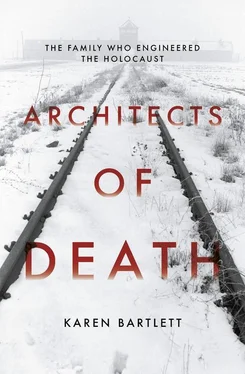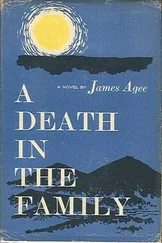It is our view that the military command is under the impression that the war work carried out by J. A. Topf and Sons is limited to the manufacture of grenades and repair of steering gear for the ‘He III’. For this reason we are writing to you again to draw your attention to the war essential task we currently have in hand, i.e. orders with priority status S and SS, as well as construction priority O, which we are required to fulfil within the next few months. [55] Topf and Sons application for Uk status, Landesarchiv Thüringen - Hauptstaatsarchiv Weimar.
The Topfs listed their order for essential war contracts, totalling 7.8 million RM, which include parts and repairs, mines, aircraft, oil, light metal plants and agriculture and food. Finally they noted another customer – whose order only accounts for 150,000 RM, but which receives special emphasis: ‘The Reichsführer of the SS (approx. twenty-five cremation ovens for prison camps in the East – extremely urgent!)
To back up this application, the Topf brothers played their trump card – their relationship with the SS. On the day before they submitted the application, someone from the company in Erfurt rang the SS Construction Management Unit at Auschwitz. Following this call, the camp’s deputy construction manager, SS-Obersturmführer Walter Urbanczyk, wrote a letter to military command in Weimar outlining an expected arrival of 120,000 Russian prisoners, meaning that ‘the construction of the cremation system has, therefore, become extremely urgent’. The person responsible for the installation of this system, Urbanczyk claimed, was Ludwig Topf, but ‘we were today informed in a telephone conversation with Topf and Sons that they will be unable to install this cremation system because the above-mentioned Ludwig Topf has been called up as a construction soldier.’ Urbanczyk requested that Ludwig be released from military duties for three weeks to oversee the Auschwitz work – but again military command ignored this request, perhaps seeing it for the fabrication that it was.
Faced with the stark reality of military service, Ludwig and Ernst Wolfgang must have been dismayed when they realised that only one man could save them: Kurt Prüfer. On 21 November Prüfer wrote to the head of construction at Auschwitz, Karl Bischoff, to discuss his recent visit to the SS Main Office for Household and Buildings in Berlin, before going back to the urgent and ‘problematic’ nature of the oven installation at Auschwitz. Under the circumstances, Prüfer writes, he has asked Ludwig Topf, ‘who came up with the idea for the three-muffle cremation oven’ to take an interest in the project and to visit the camp in person. To do this, however, he would need to be released from his military duties, and Prüfer suggests, Bischoff could write a telegram to Topf and Sons explaining why Ludwig is so vital to the project’s success. Helpfully, he even provided Bischoff with an outline of what to say:
Herr Topf is currently a construction soldier with the Third Construction Ersatz Regiment… since he is about to be granted a leave of absence, I would ask you to send a telegram to my company, and would suggest the following wording: ‘Urgently request visit from Herr Ludwig Topf from 2 to 5 December for discussion new oven construction.’ [56] Letter from Prüfer to Bischoff about Ludwig Topf’s army status, Landesarchiv Thüringen -Hauptstaatsarchiv Weimar.
Ludwig’s presence would allow him to see for himself the urgency of the operation, Prüfer concludes, ‘this would then have a positive effect on our delivery times’.
This time the effort is successful. The SS send the telegram, which still exists with handwritten notes. Ludwig Topf is granted his leave and never returns to military service. Prüfer, meanwhile, has demonstrated the strength of his connections with the SS; he is recognised as an equal when bargaining with them. (It is something he attempts again when trying to secure the release of the son of a Topf and Sons’ foreman from Buchenwald in 1943 – but on that occasion he fails.)
Prüfer and the Topf brothers never develop a warm relationship, but Prüfer now realises that he has a powerful tool at his disposal. In the fevered atmosphere of Topf and Sons in the 1940s, it is not surprising that an employee might use any leverage available.
During this period company memos and letters in the Topf and Sons archive reveal a snapshot of life in the company in one short space of time. From February to April 1942, the company was working with the Nazi regime to begin implementing the ‘final solution’ of the total extermination of the Jewish race – but the Topf archives reveal not a hint of this. Instead of documenting a business in a state of meltdown over such a moral calamity, the files tell the story of a company riven by factional fighting, fear and suspicion, with the directors themselves preoccupied with petty disputes, and unable to control their employees’ behaviour.
Over the course of six weeks, company files detail a range of volatile and unpredictable revelations, beginning with allegations that Ernst Wolfgang Topf had insulted his workers by turning up drunk one night and calling them ‘communist pigs’. On 16 February, the Nazi shop steward Eduard Pudenz writes the following memo:
On the morning of 16 February 1942, the foreman, Nagel, came to my office and told me the following:
Herr E. W. Topf had gone into the turning shop one night and had called the operators working there ‘communist pigs’. This had been discussed by the metal workers, and if true, ‘people would be very angry about it’.
Following an investigation, there is disagreement about whether Ernst Wolfgang called his workers ‘communist pigs’ or actually said: ‘Come on, you communists! I want to go and have a bite of bread with you!’ [57] Memo about E. W. Topf calling workers ‘Communist pigs’ 1942, Landesarchiv Thüringen - Hauptstaatsarchiv Weimar.
Many meeting and memos concerning this incident follow, but this startling exchange reveals several things about life at Topf and Sons. It suggests that the Topf brothers were aware of the communist groups operating in their workshop; that Ernst Wolfgang’s behaviour was sufficiently questionable that the idea of him turning up drunk in the middle of the night and hurling abuse at staff seemed plausible; and that even the lowliest workers regarded the Topf brothers with more disdain than fear.
Pudenz resolves to get to the bottom of the matter, but before he can investigate further, an even more worrying situation transpires. Later that same day, he discovers an explosive canister on the company premises:
FILE NOTE
Herr E. W. Topf
Re ‘Explosive capsule’ found on company premises
Shop steward Pudenz appeared at 15:15 and showed us a small capsule from which a number of fuses were hanging… We reported it to the Security Service, via the fire authority, since we wanted to know the nature of the object, i.e. was it just a harmless firework or a device that had been set to explode? LT [Ludwig Topf] personally handed the explosive device to the security service. They will investigate its contents and, if appropriate, inform the Gestapo.
Erfurt, 17 February 1942
[58] Topf and Sons memo concerning the discovery of an explosive capsule, 1942, Landesarchiv Thüringen - Hauptstaatsarchiv Weimar.
No one seems particularly astonished that a member of the workforce would want to blow up the company – even taking into consideration the fact that Topf and Sons employed opponents of the regime.
There are now two serious staff issues under investigation, but dissent in the workforce, and questions about Ernst Wolfgang’s treatment of his staff, raises its head again only ten days later in lengthy discussions concerning the resignation of Fritz Meier, a senior administrator who has been working closely with Ernst Wolfgang for over a year. Due to the war regulations, Meier must request permission to leave his job, and he makes it clear in a conversation with Ludwig exactly why he wishes to do so. At 10 a.m. on 27 February they sit down for a meeting: ‘Meier replied that Herr E. T. had spoken about him in highly abusive terms. It was therefore impossible for him to remain in the company. When Herr L. T. asked Meier to repeat the defamatory word or words, Meier initially refused, before saying E. T. had called him an ‘arsehole’. [59] Fritz Meier resignation, Landesarchiv Thüringen - Hauptstaatsarchiv Weimar.
Читать дальше












